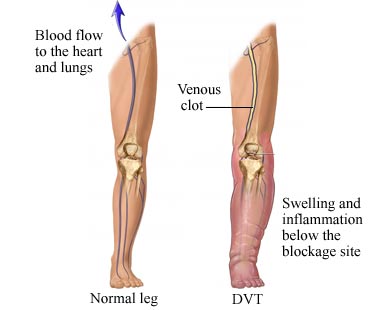
Any medical condition that is not promptly diagnosed and properly treated can have serious consequences. Of particular concern to both patients and medical professionals are those conditions that, when not properly treated, can quickly escalate to life-threatening status.
One such condition is Deep Vein Thrombosis (DVT), a potentially deadly condition caused by a blood clot that forms in a vein, most commonly in the deep veins of the leg. DVT often causes pain and swelling in the legs, but sometimes it produces no symptoms at all. If a blood clot in a deep leg vein type breaks off, it can travel in the blood stream to the lungs. This situation, called a Pulmonary Embolism, often causes shortness of breath and chest pain, and if the lung damage is severe, it can cause a quick death before treatment can be administered.
Although there are several known and effective methods to prevent and treat blood clots, a 2004 study reported in the American Journal of Cardiology that almost one half of patients diagnosed with a DVT in the hospital did not receive any of these preventive methods.
Who is Affected by DVT
Although many are unfamiliar with Deep Vein Thrombosis, it is a common medical problem. Blood clots form in the leg when a vein is damaged or if blood flow in the vein is slow or has stopped. If the clot is in a deep vein, it is called DVT, a condition experienced by two million Americans each year, many of whom aren't even aware of it. And of those who develop a pulmonary embolism, 200,00 die each year, more than the death toll in the US from breast cancer and AIDS combined!
Some people are prone to blood clots in the legs. The likelihood increases with age and doubles with each decade of life over 40. People who have had them in the past are more likely to get them in the future, as are those whose parents had a DVT. Other factors that increase the chance of getting a DVT include:
- Major surgery under general anesthesia, particularly those involving leg joints or a hip
- Obesity
- Varicose veins
- Prolonged immobility or confinement to bed
- Serious illnesses such as cancer, heart or lung problems
- Paralysis
- Pregnancy and childbirth
- Estrogen treatment
- Long-distance travel

Diagnosing a DVT
The most common methods for detecting a DVT are:
d-Dimer test - A blood test to detect clot formation
Ultrasound of the legs - Good for detecting large clots but can miss smaller ones
Blood samples - to check for conditions such as inherited predisposition to clotting
Venogram - Involves injecting dye into the veins of the foot and taking x-rays in the leg to detect blockage
Preventing a DVT
The best way to avoid DVT problems is to prevent a DVT before it happens by:
- Regularly exercising the legs - A brisk walk every day is excellent
- Maintain a reasonable body weight
- Avoid sitting or lying in bed for long periods
- Avoid tight fitting or restrictive clothing
- Avoid sitting for long periods with both feet on the floor (i.e. legs uncrossed)
- Take anti-coagulant medicines as prescribed by a physician
- During long distance travel, exercise the legs once every hour if possible
- Wear Graduated Compression stockings to assist blood flow and reduce swelling of the legs
Treatment after a DVT is Diagnosed
After diagnosis, prompt treatment is absolutely necessary in order to:
- Prevent enlargement of the clot
- Prevent the clot from moving to the lungs
- Prevent new clots from forming
- Reduce post-thrombotic syndromes
The major treatment for a DVT is anticoagulant medicines which turn off the clotting system in the body. The length of time that the drug must be taken depends on the patient’s situation. If the clot was not provoked or caused by some chronic conditions, best treatment will be using an anticoagulant for a period of minimum 6 months. However, if the patient has had two or more unprovoked recurrent clots or if there is a biochemical condition that increases the risk of clot formation, then an anticoagulant may be required for the rest of the patient’s life.
To reduce the swelling caused by DVTs and prevent other side effects (known as Post-Thrombotic Syndrome), physicians often recommend that patients wear graduated compressions stockings throughout the day. These stockings come in different lengths and different levels of compression pressure. Patients should consult their health care provider for advice on which design and pressure gradient level is best.
Being aware of the its signs and symptoms are critical to dealing effectively with DVT. Patient awareness together with quick intervention by a medical professional are the critical elements in avoiding this deadly and stealthy condition.


